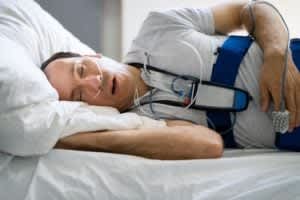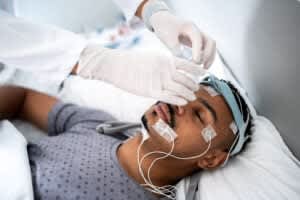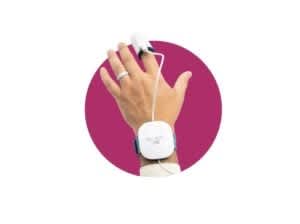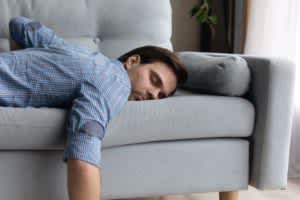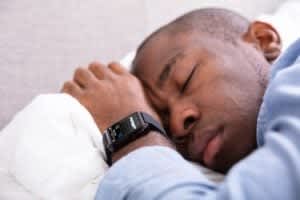When you buy through our links, we may earn a commission. Products or services may be offered by an affiliated entity. Learn more.
SleepImage Ring Review

Sleep Foundation Special Offer
Use this SleepFoundation.org link for the most current discount on SleepImage products
SleepImage is cleared by the U.S. Food and Drug Administration (FDA) for the diagnosis and management of sleep disordered breathing. SleepImage is considered Software as a Medical Device (SaMD), which the FDA defines as “software intended to be used for one or more medical purposes…without being part of a hardware medical device.” SleepImage software is most commonly used with the SleepImage Ring as the hardware device, but it is compatible with other hardware devices.
The SleepImage Ring is simple to use and comfortable to wear without compromising output quality, making it a suitable choice for people who prefer not to use at-home tests that require many different components.
During the sleep study, the user’s raw physiological data is streamed from the ring to a mobile app which then uploads the data to the SaMD, where the data is analyzed and auto-scored. The extensive data can be reviewed by the reading physician, interpreted, and manually scored for diagnosis of obstructive sleep apnea (OSA) and central sleep apnea (CSA). The SleepImage system can be used in children over the age of 2 and adults.
SleepImage is a prescription medical device that is sold to licensed health care professionals for use with the people they treat. We’ll explain how the SleepImage Ring works, what it measures, and what users can expect to pay. We’ll also cover who might find this device beneficial and who should look for a different type of at-home sleep apnea test.
What Is Obstructive Sleep Apnea (OSA)?
OSA is a widespread sleep disorder that affects between 10 and 30 percent of adults in the U.S. It’s characterized by breathing disruptions that occur when a person’s upper airway collapses during sleep, leading them to snort, choke, gasp, or snore. Complete pauses in breathing are called apneas, while shallow breaths are referred to as hypopneas. Apneas and hypopneas occur when the soft palate, muscles around the throat, or tongue block a person’s breathing passage.
Medical professionals measure OSA severity by monitoring a person’s breathing during sleep to determine their apnea-hypopnea index (AHI). This is calculated by averaging the number of apneas and hypopneas that occur during each hour of sleep. In order to be diagnosed with OSA, a person must have a minimum AHI of 5.
| AHI Score | Sleep Apnea Severity |
|---|---|
| 5-15 | Mild OSA |
| 15-30 | Moderate OSA |
| 30+ | Severe OSA |
Almost 1 billion people across the world have OSA, and there are some populations who are more likely to develop the disorder. Aging people, men and people assigned male at birth, those with a high body mass index (BMI), and people with above-average neck circumferences are all at higher risk for OSA. Common symptoms include loud snoring, restlessness, morning headaches, forgetfulness, and irritability.
The first step in treating OSA begins with a sleep study. In-person and at-home sleep apnea tests provide doctors with important data that help them determine the best treatment option for your individual needs. Leaving OSA untreated can result in increased risk of cardiovascular problems, workplace accidents, diabetes, and depression.
How Does the SleepImage Ring Work?
The SleepImage System Output is based on collecting signals controlled by the autonomic nervous system during sleep to measure:
- Wake vs. sleep
- Sleep states (NREM vs. REM)
- Sleep stages (stable vs. unstable NREM)
- Objective sleep quality using the FDA-cleared Sleep Quality Index (SQI)
- Respiration
- Blood oxygenation (SpO2)
- Movement (actigraphy)
The SleepImage System is FDA-cleared to provide comparable output to a polysomnography (PSG) test for diagnosing obstructive and central sleep apnea, using auto-scoring of the SleepImage Apnea Hypopnea Index (sAHI) that the doctor can manually review and re-score if desired for respiratory events using the raw data collected from the patient. Taking the test is straightforward, involving the following steps before, during, and after the study:
- Step 1: SleepImage Rings are only available for health care providers to purchase. Those interested in using the SleepImage Ring will need to locate a sleep specialist who uses this at-home test as part of a sleep study package.
- Step 2: Once you have found a provider who offers the device, they will provide it to you to take the test. Download the accompanying app and take care to perform the test according to the instructions.
- Step 3: When you finish the test, hit the stop button on your app. Your data will be automatically uploaded, using either Wi-Fi or your cellular network. From there, your doctor can view your data, accept or reject your results, manually review or edit them, and generate a report with your diagnosis.
- Step 4: Return the device to your health care provider and schedule a follow-up appointment to discuss your results. If your physician diagnoses you with sleep apnea, you may be prescribed continuous positive airway pressure (CPAP) therapy or another type of treatment plan.
How Do You Set Up and Use the SleepImage Ring?
Using the SleepImage Ring requires an Apple or Android device that must be kept within Bluetooth range during the sleep study, as well as an internet connection (Wi-Fi or cellular) to upload the study after it has been completed. Before starting your sleep study, download the SleepImage mobile app and enter the login information provided by your physician. Make sure that Bluetooth is enabled within the SleepImage mobile app (rather than adjusting your Bluetooth in your phone’s settings). Then, put the ring on any finger on your left hand, preferably the thumb or index finger, making sure that it has a snug fit without being uncomfortable.
The ring automatically turns on once you place it on your finger. Use the SleepImage app to search for the ring and select it to pair it with your mobile device when the name appears. Once the ring and your phone are paired, you can begin the study. Click the play button on the app when you are going to sleep (not before getting into bed to read or watch TV). The app should show both your pulse and blood oxygen level. If you get up during the night and leave the Bluetooth range, make sure that the app begins recording again before going back to sleep.
When you wake up, press the stop button. Your test will be automatically uploaded from the SleepImage mobile app to the SleepImage SaMD. SleepImage recommends that you fully charge the ring each night if you have been prescribed a multi-night study. You can recharge the ring with the USB cable that comes with the ring. Your physician can access your sleep data once it’s uploaded to the secure clinical portal in the cloud.
Who Should Use the SleepImage Ring?
The SleepImage Ring is an excellent choice for those seeking a sleep apnea test that is unlikely to interfere with their sleep. This ring is easier to use than most other types of at-home tests and has been cleared for both children and adults by the FDA. The SleepImage mobile app makes it easy to see whether the test is working, and the USB charging port ensures you can complete multi-night testing without having to get a new device or any new consumables. There is nothing that needs to be glued to your skin to take the test.
The SleepImage Ring is a worthwhile choice for many sleepers, but there are certain individuals who might find it particularly beneficial.
- Those who already use a CPAP machine: Since this device only rests on your finger, it’s easy to use along with your CPAP machine. Gathering data while using your device can help your health care team gain insight into how well your treatment plan is working.
- Sleepers of all ages: The SleepImage Ring is FDA-cleared for both children and adults, and the ring is intended to fit different finger sizes.
- People looking for a streamlined sleep apnea test: This at-home study requires fewer components than other styles of sleep apnea tests, making it a good option for those who have trouble sleeping while wearing a nasal cannula or effort belt.
- Those seeking basic health information: The SleepImage Ring is FDA-cleared to measure health metrics that have been associated with risk of cardiovascular disease, cardiometabolic conditions, and mental health that are useful for health or disease management beyond sleep apnea. This device is best for people looking for broad information on both sleep itself and sleep apnea, including information on sleep stability, sleep fragmentation, and insomnia symptoms.
This at-home sleep apnea test collects a broad spectrum of data that will provide in-depth information about sleep stages, sleep fragmentation, respiration, and blood oxygen desaturations, in addition to the presence, absence, and severity of sleep apnea. It’s not a suitable choice for those who are looking for body position metrics.
Pros and Cons of The SleepImage Ring
The SleepImage Ring offers several advantages that are worth considering if you’re looking for an easy-to-use at-home sleep apnea test.
- Minimally invasive: Most at-home sleep apnea tests have at least two wearable components, and some have as many as five. The SleepImage Ring is very unlikely to disrupt your sleep or make you uncomfortable.
- Rechargeable: If you have to repeat your test, you can recharge the device using the USB port. Other tests require you to send the device back to your doctor before performing the study a second time.
- Comprehensive: If you want sleep data in addition to sleep apnea data without having to go to a sleep center for an overnight test, this is an excellent test that will give you better insight to your sleep health.
Though this device is extremely convenient, you should consider the following:
- Price and accessibility: If you’re only looking for blood oxygen level and pulse data, there are a range of other devices that can collect this data that are typically consumer devices and thus may be more affordable and easier to access. These include sleep trackers, smart watches, and fitness trackers.
- Limitations: This device measures your sleep through the autonomic nervous system which controls your heartbeat, respiration, and sleep drive. It does not track body position or brain waves.
- Doesn’t rule out additional testing: Even after using the SleepImage System, your health care team may determine that you might need a sleep study in a hospital or clinic. If you’re prescribed CPAP therapy, you may also need to have a titration test to determine the correct pressure settings for your machine, as is commonly done regardless of what home sleep test is used for the diagnosis of your sleep apnea.
Cost, Shipping, and Returns
Since access to the SleepImage System, including the SleepImage Ring, can only be purchased by health care providers, users are only responsible for the cost of renting the device along with any other features that your health care team might include. The exact cost will vary depending on your physician and insurance provider, but it’s likely to be less expensive than an in-person sleep study in a sleep center. Those diagnosed with OSA will also need to schedule follow-up appointments that may add to the overall cost.
Medicare only covers certain types of at-home sleep apnea tests. The SleepImage System meets the definition of channels required for using CPT 95800 for diagnosis and CPT 99543, 99454, 99457, and 99458 for remote patient monitoring. SleepImage is a prescription medical device, so you will need a medical professional to prescribe the test to you. You will get your results, including your sleep report, from your doctor. Shipping and rental specifics vary by provider. The device comes with a warranty to the medical professional, who will explain your responsibility for use of the device that is lent to you to take your test.
The Bottom Line
The SleepImage Ring is an extremely comfortable and user-friendly at-home sleep apnea test. It’s an outstanding choice for people looking to take an easy and comprehensive test of their sleep health, including sleep apnea. The device uses a unique and FDA-cleared software that provides actionable information on your health during sleep. It provides data that can help you monitor your sleep health over time with personalized sleep health reports that may help you manage your sleep apnea treatment or any other chronic condition that is known to be affected by poor sleep or the presence of sleep apnea.
The SleepImage system reports six channels of data that will give your physician a detailed view of your sleep, respiration, blood oxygenation, and movement during sleep. Health care providers can use the SleepImage software to determine if the user’s data indicates obstructive or central sleep apnea. SleepImage is FDA-cleared for evaluation of sleep disorders (including OSA, CSA, and insomnia) and in the case of OSA and CSA, it is cleared for both diagnosis and management. The SleepImage Ring is well suited for people who want to manage their health during sleep, from diagnosis to treatment tracking. If you experience poor sleep unrelated to sleep apnea, it can be a helpful tool to manage lifestyle, stress, and anxiety to help you take further steps toward better understanding your sleep health.

Still have questions?
Our product experts have extensive experience testing just about every sleep product on the market. Send an email to [email protected] or call us at (877) 672-8966 with your questions and we’ll help you find exactly what you’re looking for.

